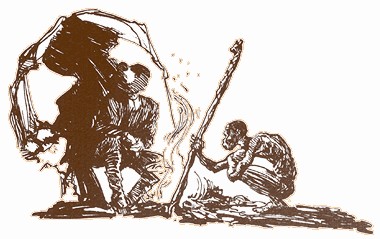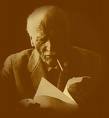Jung At Heart
Friday, April 3, 2009
posted by Steve Trout
 Print This Post
Print This Post
“It certainly does seem that certain individuals occasionally get in contact with forces outside themselves, something like cog-wheels grinding away in their spirits, that suddenly, perhaps only momentarily, slip into the notches of gigantic, unseen cog-wheels of cosmic scope. Maybe that’s what is meant by ‘getting in touch with the infinite.'”
-REH to CAS, undated.
Carl Jung introduced the idea of an archetype as a kind of prototypical concept, a basic building block of ideas. Jung thought of the archetypes as pychological “organs”, the product of mental or psychological morphology. Similarly, Jung believed the collective unconsciousness was a shared heritage bequeathed by our evolution, which shaped our minds just as it shaped our physical bodies.
Although we can study the genetic code that we carry for the shaping of our bodies, the collective unconsciousness can only be guessed at by the way it reveals itself to us in dreams, myth, religion and creative art. Through a life of study, Jung found that certain symbolic themes are universal. These archetypes are the hallmarks, the DNA, of the collective unconsciousness. Expanding on this, Joseph Campbell began working on the idea of a monomyth, a hero tale shared in its basic form by all cultures, even our pop culture; the monomyth involves a monumental task placed on a hero, who rises to meet the challenge through learning and growth (at the hand of a mentor of some sort, usually, who he will than grow to surpass).

It is not hard to see a similarity to the growth patterns of sons who learn from their father only to one day outstrip his abilities, as they grow to maturity while their father ages. Every individual must face his hero’s task in one way or another, if he is to find his own way in the world.
Wikipedia’s entry on Jung states:
The overarching goal of Jung’s work was the reconciliation of the life of the individual with the world of the supra-personal archetypes. He came to see the individual’s encounter with the unconscious as central to this process. The human experiences the unconscious through symbols encountered in all aspects of life: in dreams, art, religion, and the symbolic dramas we enact in our relationships and life pursuits. Essential to the encounter with the unconscious, and the reconciliation of the individual’s consciousness with this broader world, is learning this symbolic language. Only through attention and openness to this world (which is quite foreign to the modern Western mind) is the individual able to harmonize his life with these suprapersonal archetypal forces.
Jung listed four main forms of archetypes:
- The Self
- The Shadow
- The Anima
- The Animus
The self is the ego; what we generally consider “us”. People may have a good or poor perception or what kind of people they really are, but most have some sort of an idea.

The shadow is an unconscious complex that is defined as the diametrical opposite of the conscious self, the ego. The shadow represents everything that the conscious person does not wish to acknowledge within themselves. For instance, someone who identifies as being kind has a shadow that is harsh or unkind. Conversely, an individual who is brutal has a kind shadow. The shadow of persons who are convinced that they are ugly appears to be beautiful.
The shadow is not necessarily good or bad. It simply counterbalances some of the one-sided dimensions of our personality. Jung emphasized the importance of being aware of shadow material and incorporating it into conscious awareness. Otherwise we project these attributes onto others. The shadow in dreams is often represented by dark figures of the same gender as the dreamer, such as gangsters or prostitutes or beggars or liars.
The Jungian idea of the shadow makes up a large part of the intellectual foundations of the Earthsea stories, the classic fantasy series written by Ursula le Guin. If you are familiar with the Earthsea story, the major conflict arises when Ged unwittingly looses his shadow out into the world. Evil sorcerers, in general, are shadow figures. One might conclude that Howard’s work has an abundance of shadows, perhaps because his soft-hearted nature spawned a powerful shadow of cruelty, which he poured into his fiction.
This from the GATES OF EMPIRE book notes on Amazon:
“Sowers of the Thunder” pits two evenly matched characters against one another: Red Cahal is an exiled Irish prince who has been cheated out of kingship. The red-haired Baibars the Panther is a former slave who will one day seize a throne. Figuratively, one man will be the death of the other, and in a sense this is Howard’s version of Poe’s classic “William Wilson”, played out against the turbulent background of the 13th Century
“William Wilson” is as clear a case of man against his (perhaps mystical) shadow as the Earthsea saga. By extension Red Cahal and Baibars are shadow opposites out of Jung as well.
See my previous post for an extended discussion of the anima and animus
Symbols of the unconscious abound in Jungian psychology and some have beome recognizable types in art and fiction:
- The Syzygy (“Divine Couple”), e.g. the Oracles that serve as a link to the Powers That Be on Josh Whedon’s “Angel”
- The Child, e.g. Linus van Pelt
- The Übermensch e.g. Superman, Jahweh)
- The Hero, e.g. Siegfried, Beowulf, Doc Savage, Luke Skywalker, Thomas A. Anderson (“Neo”), and Harry Potter
- The Great Mother, either good or terrible, e.g. Glinda the Good Witch of the North
- The Wise Old Man, e.g. Obi-Wan Kenobi, Gandalf, Albus Dumbledore, Mr. Miyagi
- The Trickster or Ape, e.g. Robin Goodfellow, Brer Rabbit, Bart Simpson, Bugs Bunny, Loki
- The Puer Aeternus (Latin for “eternal boy”), e.g. Peter Pan
Carl Jung used the term “syzygy” to denote an archetypal pairing of contrasexual opposites, which symbolized the communication of the conscious and unconscious minds. I’m not sure, but it seems some of the brother and sister pairs — (“People of the Black Circle,” “Black Canaan,” “Dermod’s Bane”) found in the stories may reflect this archetype. Howard’s unborn sister may have been an influence reaching from his subconscious — there seems to be a pattern of one surviving sibling, one dying — except for “Black Canaan, where both are villians to be killed.”
The choice of Linus here is meant to point out the key characteristics of the child as a symbol of the unconscience — though young, he is wiser than his years — a philosopher, a sensitive, perhaps even somewhat fey. Some of the younger characters in Howard (there are not many) share this preternatural wisdom — Eevin in “The Grey God Passes” and Tina in “The Black Stranger” are both described as being children or close to them, yet uncannily wise, even Seers.
There is no clearly omnipotent force in the Howard universe, unless you want to argue Solomon Kane’s God truly enters the scene in “Moon of Skulls”. His thundering absence from “Wings in the Knight” however, argues against it. I have argued in the past that there is an ubermensch nature to Conan, though; handled much like Jack London did, i.e. to make memorable larger-than-life characters, after reading Nietzche on his Yukon travels. The colorful Kryptonian is kind of a red herring, as his powers are so super-human and his alien origin calls into question whether he really is a man, uber or otherwise.
Unlike Howard heroes in general, these develop over their quests to meet the challenges they must face. A Howard hero usually springs forth at the start with all the powers he will need to face the struggle — an important exception would be Hour of the Dragon, and there is the galley slave body-building of “Lion of Tiberius”. Conan develops from a raw stripling into a mature hero over the course of the series.
Ishtar appears as a real entity in “Marchers of Valhalla” — she is also one of the prominent dieties of the Hyborian Age.

Kull’s advisor Tu and Kane’s blood-brother N’longa are two of the most prominent wise men in the canon, but Hadrathis and the witch Zelata from “Hour of the Dragon” provided important aid to Conan’s quest. It is striking to note the similarities of Yoda and N’longa — hermits with magic powers, a different skin-color from the hero, small, bent-over, with a poor command of the language. Sort of like a helpful Leprechaun of color.
Apes abound in Howard, but they are creatures of menace, not mischief. The Ape as trickster is seen most clearly in Thak from “Rogues” as he mimics his master; other apes are not as fully characterized but “Shadows in the Moon” also has some traits in this regard.
“Gates of Empire” has Howard’s most comic human trickster character — an overweight alcoholic Bart Simpson from the Middle Ages.
The Puer Aeternus figure is not readily obvious in Howard, except as it plays a factor in the eternal innocence of a Breck or Costigan.

